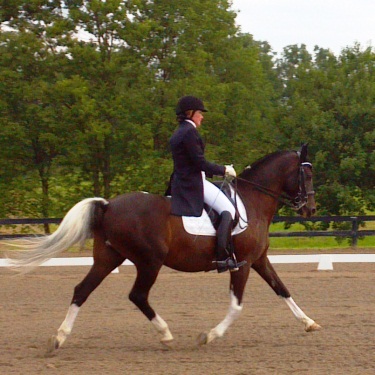As an adult amateur dressage rider, Lynda McNeely’s goal was to show at second level and complete a first level freestyle. She hoped, with the help of trainer Sue Kolstad, she would be able to make that happen. But when she first began riding with Kolstad in 2002, McNeely had an Arabian gelding who wasn’t working out.
“She was a little afraid of him,” said Kolstad, Burlington, Ky. “So I said, ‘You need a Curly horse.’ “
Although it might have seemed like an out-of-the-box suggestion to an outsider, Kolstad became familiar with the American Bashkir Curly horse when she lived in Indianapolis and began training horses for breeder Sandra Hendrickson of Greycoat Farm. Hendrickson started breeding her Curly stallion, Spartacus, to Morgan mares.
“Sandy had a mission. She wanted to make the Curly horse famous, so she bred Spartacus, and every one of the babies’ names start with ‘Spar.’ All of her horses are athletes; that was her goal—to produce a sport horse, and she has done a tremendous job,” said Kolstad.
American Bashkir Curly horses are often recognizable by their distinctive coat, which is usually curly in texture. Although the American Bashkir Curly Horse Registry states the breed’s origin is unknown, studies show that they’ve been in the United States since the early 1800s. Another one of their unique characteristics is that they are hypoallergenic.
“The Curly horse is known for being calmer,” said Kolstad, who is a U.S. Dressage Federation S-rated judge. “They have a really great mind. They’re very practical. They’re alert and aware, but they’re not spooky.”
Upon McNeely’s agreement, Kolstad approached Hendrickson about purchasing one of her horses. Kolstad had already trained one of the homebreds to Prix St. Georges, so she knew their ability.
“[Sandy] mentioned Spar Trek. I’d known him when he was a little baby, and I thought he was really cool and a great mover,” said Kolstad.
In 2003, Spar Trek (Spartacus—Vintry), half Bashkir Curly and half Thoroughbred, was a 3-year-old unbroken colt.
ADVERTISEMENT
“I bought him sight unseen,” said McNeely, Burlington, Ky. “When I got him, his owner told me I could try him for three months, and if he worked out—great. But if he didn’t, I could bring him back. It didn’t take long to see that he was a great fit.”
With Kolstad’s guidance, “Marley,” who picked up the nickname because of his dreadlocked mane, began showing at training level in 2005. In 2013, Kolstad showed the now-gelding at Intermediaire 1, and McNeely rode him at Prix St. Georges.
“He has received the USDF All Breeds Horse of the Year Award [for the Curly Sporthorse International breed registry] from training level through I1. I got all my scores for my [USDF] bronze medal on him, and my goal is to finish him out and get my silver [medal] with all scores from him,” said McNeely. “And we will.”
Holding His Own
Kolstad’s training theory is to keep Marley a step ahead of McNeely. Although Marley might have Grand Prix potential, the plan is to not exceed I1.
“He has a piaffe on him, and I’ve started the one-tempis, but I’m not training him for me—I’m training him for his owner. And right now she is in ecstasy riding at Prix St. Georges. So if I get him too far ahead of her, it becomes more difficult for her,” said Kolstad.
Marley does not have a noticeably curly coat, and his markings often having people guessing a different breed.
“People ask if he’s from the Art Deco line,” said McNeely of the famous pinto warmblood sire. “Or because he’s 15.1, we also get German Riding Pony.”
McNeely, who called her gelding “a sports car,” notes that although he is laidback, he has a cheeky side to his character, too.
ADVERTISEMENT
“He can be a cocky little guy. We’ve gotten judges’ comments in the show ring like ‘Dennis the Menace personality’ or ‘well ridden through temper tantrums,’ but he’s taught me more than any quiet, made horse could have,” said McNeely
For Marley to be competitive against warmbloods, the gelding must perform his movements without any errors.
“With correct training, I can produce the quality of the gaits with him. And he’s getting more and more beautiful,” said Kolstad. “But what’s kind of funny is that nobody really noticed him until she showed up in a shadbelly and double bridle.”
“To me, Marley is the epitome of a horse that is athletic but not spectacular, but with training has become really good horse. He’s well put together. He’s holding his own at this level because he’s correct. You’ve got to get the scores at the non-brilliant movements—the halt, for example. Anyone can do them; it’s not any different from a $100,000 horse,” McNeely added. “I know he’s not going to beat warmbloods that score a 9 for their gaits, but that doesn’t bother me. I’m happy to know we can get to this level, and he can be competitive.”
This story is part of our series on dressage horses of unusual breeds. Read more…
“Haidaseeker Playboy Wears Several Different Hats—And Shoes” about a Quarter Horse who splits his time between dressage and reining.
“I’ve Been Ripped Is Making His Mark In The Dressage Ring” about an Arabian-Paint cross competing at the FEI levels.
Do you have a non-traditional breed competing in dressage? Let us know!















